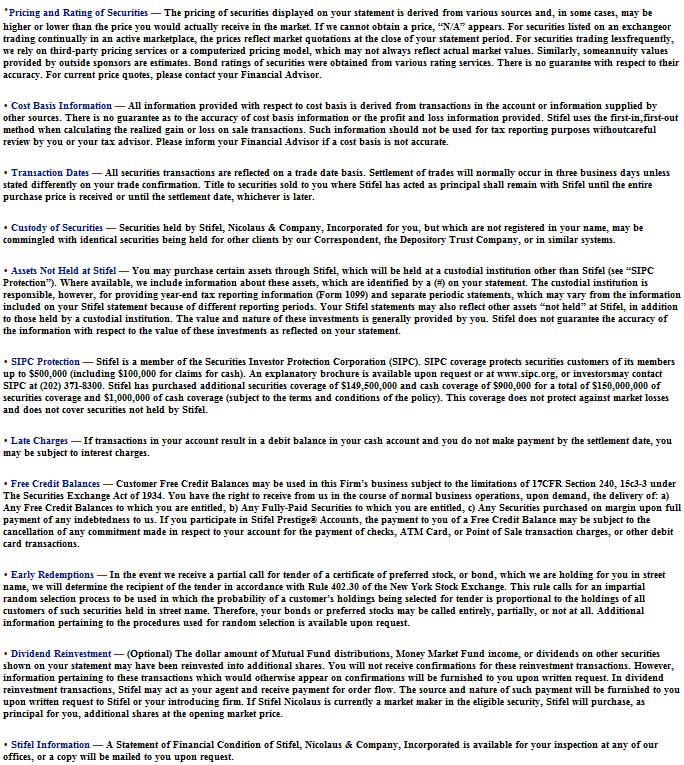|
ROLLOVER
CENTER |
| |
|
| |
STIFEL NICOLAUS |
| |
|
|
Investment StrategistTM
Dealing
With Market Volatility
March 2008
|
The stock market has taken investors on a roller coaster ride
since the beginning of the year, with wide swings occurring on an
almost daily basis. At this point, significant fluctuations in
indexes such as the Dow Jones Industrial Average and the Standard
& Poor�s 500 have become a fact of life. With important financial
goals, such as retirement, on the line, it can be unnerving to see
the value of your investments rise and fall. As an investor, what
can you do to prepare yourself for such volatility? We have a few
suggestions that may help you better deal with the current
instability in the market. |
 |
Build a
Diversified Portfolio
When one
type of investment is down, another might be up. Building a
diversified portfolio is a great way to help minimize investment risk,
and the key to diversification lies in proper asset allocation � that
is, spreading your money across different asset classes, such as
stocks, bonds, and cash equivalents. And within those asset classes,
further diversifying your portfolio by maintaining a mix of
investments (large- and small-cap stocks, long- and short-term bonds,
for instance), can potentially provide you with the stability you need
in order to handle periods of market volatility.
By balancing
your risk and returns over several asset classes and investment types,
you may experience less fluctuation in the value of your portfolio.
The mix of investments that�s best for your unique situation will
depend on a number of factors, including your age, time horizon, and
tolerance for risk. While diversification does not assure a profit or
protect against loss, asset allocation is important in all of your
investments, from your 401K and IRAs to your college savings plans.
Your Stifel Financial Advisor can work with you to help recommend an
asset allocation tailored to your individual financial goals and
objectives.
Maintain a
Long-Term Focus
Over the
course of investing for long-term goals such as retirement, the market
will certainly have its share of ups and downs, but historically
speaking, it inevitably recovers from its down periods (of course,
past performance is no indication of future results). During turbulent
times, the financial media has a tendency to go overboard with reports
of gloom and doom. Amid all of the negative headlines and downbeat
economic forecasts, it�s easy to panic � don�t. Stay calm, maintain
your long-term perspective, do your best to tune out the negativity,
and try not to let |
|

V i s i o n
�
P l a n n i n
g �
F o c u
s
|
|
Dealing with Market Volatility
(continued) |
|
your
emotions cause you to make irrational decisions. Selling off a
particular investment when it�s down may bring you some temporary
peace of mind, but could come back to haunt you down the road. Don�t
overreact by making drastic changes to your portfolio based on current
market conditions.
The overall
impact of market volatility on your investments will depend on your
investment time horizon. For example, if you have just a short time
period before retirement, your portfolio will have less time to recoup
any losses sustained during a down market. On the other hand, if you
have a significant amount of time before you need to access your
investment funds, your portfolio is much more likely to have fully
recovered before that time.
|
Don�t
Try to Time the Market
There�s
an old saying that successful investing comes from time in the
market, not market timing. Many experts will also agree that
determining the �best� time to get in or out of the market can be
nearly impossible, and that for most investors, trying to time the
market is not a practical investing strategy. Trying to determine
exactly when one should aggressively invest or back out of the
market takes a considerable amount of expertise and time to
monitor market environments. And even the most savvy investors and
advisors can�t guarantee that their predictions will be correct,
since there are no guarantees when it comes to how the financial
markets will perform. |
 |
|
|
There is
an advantage to staying in the market for the long term, versus
trying to determine specific times to get in or out of the market.
This advantage can best be explained with the concept of
dollar-cost averaging. Dollar cost averaging is simply investing
equal or fixed amounts of money at regularly scheduled intervals.
With this investment strategy, you will buy more shares when the
price of your investment has declined, and fewer shares when the
price has risen. Over a period of time, you may lower your average
cost. Trying to predict when and how markets will move can be
nearly impossible and completely overwhelming. Whether you are new
to investing or a seasoned professional, dollar-cost averaging can
help you cope with price fluctuations in a volatile market.
By
dollar-cost averaging, you may reduce investment risk by not
investing substantial amounts at the wrong time. In addition,
dollar-cost averaging forces you to invest on a regular basis, as
you would in a 401K plan, for instance. By investing on a
regular basis, you can avoid making bad decisions based on
emotions, such as the natural tendency to stop investing in a weak
market.
It is
important to consider that dollar-cost averaging does not assure a
profit or protect against a loss in declining markets. Before
embracing the dollar-cost averaging strategy, you should consider
your ability to continue investing during periods of falling
prices.
|
Take
Advantage of Buying Opportunities
A
down market doesn�t necessarily have to be a bad thing. You
may be familiar with the old saying �buy low, sell high.�
During a market such as the one we�re currently experiencing,
many savvy investors are taking advantage of attractive prices
on stocks that were once considered overvalued. In today�s
market, there are thousands of strong, successful companies,
which have potential for future gains, available to investors.
Investors using the dollar-cost averaging system will already
be poised to take advantage of low prices. And, for those who
are not currently in the market, getting in at the bottom (or
close to it) may be the best time for new investors to enter.
For those investors who decide to halt their investing plans,
or liquidate their positions, they risk the opportunity |

 |
|
|
 |
| |
| |
|
to
recoup their losses when the market begins to recover. In
addition, by getting out of the market, an investor may miss some
of the market�s best single-day performances, as some financial
experts believe that the most profitable time of a bull market may
be at the beginning.
Review
Your Portfolio
Once
you�ve set a course to reach your goals, it is important to stay
in contact with your investment professional to be aware of any
necessary changes that need to be made to your portfolio in order
to continue to meet your long term goals. Marriage, divorce, or
the birth of a child are just a few major life changes that can
have a major impact on your financial needs, and you should take a
proactive approach to your investments by scheduling a periodic
consultation or review of your portfolio with your Financial
Advisor.
Living
through volatile market conditions can be overwhelming. But you
don�t have to go it alone. Your Financial Advisor can help you
understand what is happening both with your portfolio and in the
market. At Stifel, our investment philosophy is based on
a century-old tradition of providing solid, studied advice. With
over a hundred years of experience, we�ve been through all sorts
of market conditions and have the knowledge, perspective, and
experience to help you keep your investments on track during
difficult times.
|
|
Are You
Ready for a Rollover?
Considering a rollover is a good idea if you find yourself with a
lump-sum distribution due to one of following situations:
Changing jobs
� If you are about to
make a job change, you�ll be faced with choices regarding your
retirement plan. You may elect to roll over your 401K plan to an
IRA.
Retirement
� Whether you are about
to retire, or have retired already, rolling over your retirement
funds from your company�s plan to an IRA may be an attractive
option.
IRA-to-IRA Rollover
� If you�ve already
established an IRA, you may roll over one IRA to another under
certain circumstances. If eligible, you may have the option of
rolling over a traditional IRA to a Roth IRA, which may offer tax
benefits for some individuals.
Regardless of which one of the above reasons fits your situation,
it is important to review all of your options before making an
election for your lump-sum distribution. You�ll want to have an
understanding of the tax consequences and penalties that may be
involved with cashing out your plan or doing an indirect rollover
versus a direct rollover. In addition, there may be tax benefits
to an IRA, such as the ability to accumulate funds on a
tax-deferred basis, which you should be aware of. Your Financial
Advisor can also help you determine the future growth potential of
an IRA, as well as how an IRA can fit into your overall retirement
plan.
Whether
you have need for a rollover or not, you have until April 15,
2008, to contribute to or establish an IRA for the 2007 tax year.
|
|
 |
|
Account
Disclosures |
|
|
 |
|
Stifel, Nicolaus & Company, Incorporated
�
Member SIPC and New York Stock Exchange
�
One Financial Plaza, 501 North Broadway, St. Louis, Missouri 63102
�
www.stifel.com |
|
|
|

